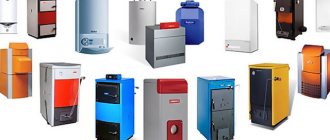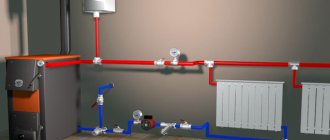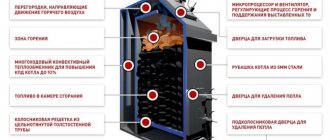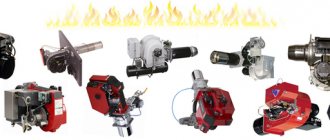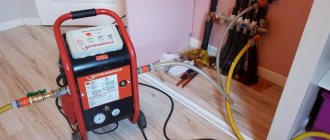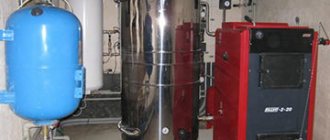When choosing heating devices to supply the house with hot water and heating, the homeowner is guided, first of all, by considerations of the appropriateness of the device in a particular case. It is necessary to calculate the economic issue - how much the equipment, its installation, and maintenance will cost. It is important and technically justified to choose a boiler so that its performance is sufficient to solve the main problem, and at the same time you do not have to overpay for unnecessary options and excess power. In some cases, it is convenient to use a system where the energy carrier is natural wood. Especially in those areas where there is no gas supply line or there are power outages.
Wood boiler for home heating Source anatomycharty.com
Types of wood boilers
Do not confuse the device with a stove: it has a different operating principle. If the stove heats the air, then wood-burning boilers for the home are designed to operate a water heating system. Hence a different approach to equipment design. The heat exchanger is located in the air overheating zone. The natural or forced movement of water in the system carries it through pipes to heating devices in the home. Having given up some of the energy, the cooled water again returns to the boiler, where it is brought to the desired temperature. The fluid circulation circuit is designed based on the design of the heating device. For this reason, it is recommended to purchase a wood-burning boiler for heating a private house with batteries before installing the heating distribution.
The most important indicator of boiler performance is its efficiency, which largely depends on the design of the combustion chamber and heat exchanger. It is customary to divide equipment intended for firewood into the following types:
- Classical.
- Boiler with top ignition for long burning.
- Pyrolysis.
- Long combustion boiler with an extended firebox.
Boiler in a heating system Source msk-kamin.ru
In addition to differences in design due to the principle of operation, devices can be equipped with additional parts. For example, pellet boilers are often equipped with automatic fuel supply. Some models have sensors that inform about current processes and help install a remote control system. Today, wood-burning boilers for home heating are efficient, modern devices that successfully compete in performance with the best examples of gas and electric equipment.
Classic wood boiler
Traditional oven-like design. The main metal container or a separate device connected to a separate storage tank is used as a heat exchanger. Efficiency depends on the correct arrangement of structural elements, their sizes, regulation system and control over the combustion process. The draft damper is installed in a position where the exhaust air flow is sufficient to prevent combustion products from entering the room. Excessive speed of convection flows is undesirable, since thermal energy will not have time to transfer the required amount of heat to the heat exchanger. Strong draft will blow hot air out into the street. System efficiency decreases and fuel consumption increases significantly.
Classic wood boiler Source gorodvitebsk.by
Boiler with top ignition
This design refers to long-burning devices. A characteristic feature of a boiler with top ignition is a fairly large volume of firewood and a controlled combustion process from top to bottom. The flame spreads more slowly. The dosed air supply does not allow the rapid spread of open fire; it is enough to maintain a certain level of combustion. As the top layer is consumed, the firewood located below begins to be included in the process. A high-quality top-burning boiler can operate on one load for up to two days.
See also: Contacts of companies that specialize in home insulation.
Boiler with top ignition Source tr.skopelitissa.com
Pyrolysis boiler
Modern productive system based on the principle of double combustion. When wood burns, gas is formed, which in a conventional firebox is discharged into the chimney. Moreover, under certain conditions, it also has the ability to release energy when burned. The design of the pyrolysis boiler consists of two compartments. In the first, the wood burns, in the second, the gas it produces. This design is often called a gas generator. Ensures more complete combustion of fuel. The efficiency of the device is higher than that of a traditional boiler. A more complex design will cost a little more, but will quickly pay for itself with lower fuel consumption. Such a boiler for heating a private house using wood is considered the most productive and economical.
Pyrolysis boiler Source projject.ru
Boiler with extended firebox
The operating principle is similar to a device with top ignition. The special design of the firebox allows the firewood to be placed in such a way that the horizontal spread of an open flame is difficult. A minimal air supply also contributes to this. The fire gradually moves from one edge of the firebox to the other. Unlike the traditional design, the release time of the potential energy of one bookmark is significantly longer. The simplicity of the boiler and high efficiency make it attractive for those who do not want or do not have the opportunity to constantly monitor the combustion process. Manufacturers are trying to offer models with a single daily load, which is very convenient both for a country woman with permanent residence, and for temporary housing, for example, a dacha.
Boiler with an extended firebox Source aquatools.com.ua
Types of heating systems
First of all, the house can be heated using an autonomous structure with forced or gravitational (natural) coolant circulation. Each of these methods has its own advantages and disadvantages. In addition, there are situations when it is better to use one or another variety.
Advantages and disadvantages of natural circulation
Gravity pumping is entirely based on the laws of physics. More precisely, the coolant moves through the pipeline due to the difference in weight between cooled and heated water.
A hot liquid has a much larger volume, but much less mass. Accordingly, it rises up the riser, moves further through pipes that are laid at an angle, and is pumped into heating radiators, where it is cooled.
Before making a final choice in favor of a certain type of fluid circulation in the system, you need to consider the pros and cons of each heating option
The list of advantages of such a solution should include ease of installation. A system with natural circulation lasts much longer and is stable. At the same time, the absence of a pump allows you to get rid of excess noise and ensure independence from the availability of electricity.
As for the disadvantages, this kind of solution can only be used when heating a small house. In addition, the system requires laying large-diameter pipes, which significantly increases the cost of organizing a home heating system.
When choosing natural circulation, you need to take a responsible approach to installation - errors will lead to a serious decrease in the speed of pumping the coolant
Distinctive features of pumping systems
To make water move faster through the pipes, a circulation pump is installed into the heating system. With its help, you can move the media with virtually no loss of temperature. As a result, a wooden building warms up much faster, which saves a considerable amount of fuel.
The main advantage of forced circulation is that the area of the heated house can be practically unlimited. At the same time, the owner is given the opportunity to control the amount of heat and the speed of the pump. The disadvantages of this solution are the dependence of the system on the availability of electricity and the high noise level of the equipment.
When installing a heating pump, you can use pipes of small diameter. This allows you to save on the purchase of plumbing fixtures
How to choose the right model
When purchasing, you should be guided by all the information about the features of the models that will be important during operation. From the ability to install in a prepared room to the quality of the wood burned. The choice of a specific model is determined by the following economic and technical characteristics:
- Price. The cheapest are classic designs. They are 2-4 times cheaper than pyrolysis analogues.
- Boiler weight. Steel construction is lighter than cast iron. The heaviest models are some types of pyrolysis boilers. Weight can reach 500 kg. This factor should be taken into account when purchasing. The floor in the boiler room must be sufficiently reinforced.
- Power. It is generally accepted that 1 kilowatt is needed per 10 m2 of area with average energy efficiency of housing. In regions with harsh climates, a correction factor is used. Sometimes it can be up to 2 units. A high level of thermal protection, on the contrary, will reduce the average value. For a “smart home” you can apply a coefficient of 0.5-0.7.
- Material of manufacture. Steel boilers are noticeably cheaper. The metal burns out faster, and the service life of such a device is about 20 years. Cast iron is more resistant to high temperatures and will withstand 35 years of regular use, and it is also more inertial. It warms up slower, but cools down longer, which in some cases is very beneficial.
Domestic wood boilers Source criptopia.ru
Criterias of choice
Knowing some of the differences between domestic models and foreign designs, as well as the amount the consumer expects, will help you choose the right wood-burning boiler with a water circuit.
Thus, it will be necessary to take into account:
- Country of manufacture;
- Design features;
- Productivity.
If the power of the unit is calculated correctly, then it can easily provide heat to areas of up to five hundred square meters. If we consider that one kilowatt is consumed per ten square meters, then for a specific area it will not be difficult to calculate the power indicator, adding from twenty to fifteen percent.
Basically, the formulas are calculated for the middle latitudes of the Russian climate, when the height of the room does not exceed two and seven meters. By using an online calculator, you can easily make a similar calculation for rooms that have a more complex configuration.
Wood boiler installation
Fundamentally, the installation of the device does not differ from a similar operation with gas equipment. However, some nuances should be taken into account. The energy carrier for the gas boiler comes through a pipe from the main line and does not require any effort from the user. During combustion, combustion products are not collected. Firewood requires a separate storage place with recommended conditions. It is advisable that they be in a dry place. High humidity reduces work efficiency, since part of the energy is spent on drying the wood. Adding fuel to the boiler and removing ash is done strictly following fire safety precautions.
Particular attention is paid to the ventilation system and chimney design. When burning, a large amount of substances harmful to health is released. Their entry into residential premises is unacceptable. Modern boilers from leading manufacturers are equipped with reliable protection systems and sensors. However, wood-burning devices are not recommended to be installed in rooms combined with living space. A steel sheet is laid under the boiler within a radius of at least 1 meter. There are no conflicts when communicating with a standard heating system.
Model of a heating system based on a wood boiler Source maltavista.ru
Which heating is better for a house made of timber: autonomous or local?
The heating system option must be chosen at the house design stage. In this case, it is necessary to take into account its intended purpose. For a country house where people do not live permanently, the heating requirements are not as stringent as for a cottage where a family with children permanently lives.
Autonomous heating systems operate independently of centralized heating networks. These systems are currently the most common heating option for low-rise buildings. Individual heating is the most effective and economical option for a private house made of timber.
There are also local heating devices. These include various convectors, heat guns, fireplaces, infrared heaters, stoves, etc. Each such device can provide a comfortable temperature only in a small space. Local heaters are installed in a separate room and are most often used to heat objects not intended for permanent residence.
Maintenance and care of a wood boiler
The main problem when operating equipment is the timely removal of combustion products. Ash is removed regularly. The high organic content in natural wood leads to rapid contamination of pipelines. The chimney becomes clogged several times faster than when using a gas boiler. With certain skills and available tools, this operation can be carried out independently. If this is not possible, then specialists are called. If the chimney is operated with a gas boiler running, then a successful pipeline configuration allows the operation to be carried out every few years. Wood-burning units require more frequent intervention. Depending on the design, the chimney is cleaned 1-2 times a year. If, with such a schedule, a significant decrease in the efficiency of the system is noticed, you should contact professionals to modify the route and improve the performance characteristics of the removal of combustion products.
Over the course of a year, 10-15 m3 of wood is used to heat a house. Prepare it in advance. Care should be taken to ensure that fuel is stored in a place protected from precipitation. A canopy will be enough. Good ventilation during installation also contributes to effective drying. The type of wood is of great importance. Conifers such as pine, spruce, and cedar are not among the best types of fuel, but they are inexpensive. Deciduous species provide greater heat output - birch, beech, oak, ash. These rocks are considered valuable, and only waste and non-business materials are used as fuel.
Boiler in need of cleaning Source vsaunu777.ru
Economic benefits when using a wood boiler
It is no coincidence that many reputable manufacturers have launched the production of equipment in this category. The demand for it is high not only in Russia and the CIS countries. Today, wood-burning boilers for homes with water heating are successfully used in many regions of Europe, America and Asia. The secret is simple - high prices for gas and electricity have led to the fact that servicing the corresponding equipment is expensive. In many countries, the production of pellets from waste from the woodworking and furniture industries has been established. The granules take up little space and are highly energy efficient. Moderate prices make their use extremely attractive. The cost of heating a house of 100-150 m2 with wood at the average market price is 10,000 -15,000 rubles. This is even lower than when using gas, although it is considered the most cost-effective energy carrier. In practice, it turns out that using the latest generation high-performance wood-burning boiler is more profitable than connecting gas equipment. Electricity will cost even more.
Design project for an individual boiler room Source stroi-archive.ru
In regions where cheap wood is available, these figures are even more impressive. In some areas there is a quota for independent fuel procurement. There are many wood processing enterprises across the country, for which a constant problem is the presence of large amounts of waste. Not all enterprises in the industry have established full processing lines. If there is such a production in the neighborhood, then installing a wood-burning boiler will significantly save the family budget.
